LadyLucks complete Roulette Guide
In this article, LadyLucks offers you the best and most detailed roulette guide! We will talk about the history of wheels and the strategies to adopt to maximize your earnings!
History of Roulette
Roulette was stumbled upon by chance in 1665 by French mathematician Blaise Pascal, not in an attempt to create a casino game, but to do the impossible – invent the first perpetual motion machine.
Perpetual motion, or ‘overnuity’, was the theory that a machine could be operated endlessly without an energy source. The furore surrounding these machines first took storm in the 17th century, with acclaimed scientists of the time Robert Fludd and his failed “Water Screw”, Robert Boyle with his unsuccessful “Perpetual Vase” (discussed in the 1685 edition of Philosophical Transactions) and Georg Andreas Bockler’s “self-operated”, but ultimately disastrous water mill generating a fair amount of media-attention at the time.
Tragically, these machines were impossible to create, as would be clarified by the first and second law of thermodynamics agreed upon towards the back end of the 18th century.
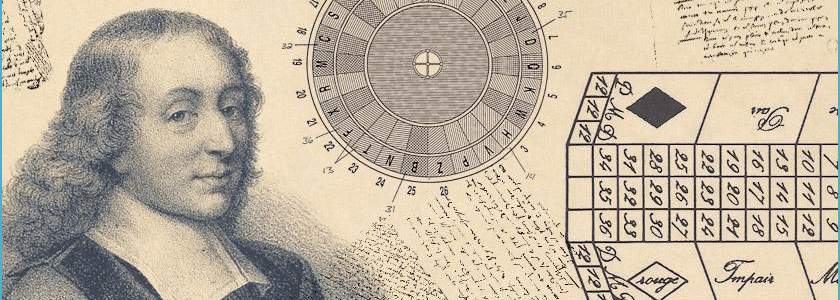
It was during this era that Blaise Pascal, most famous for mathematical breakthroughs such as “Pascal’s Triangle” and projective geometry – the study of geometry not based on the concept of distance – made his own attempt at a perpetual motion machine in the form of a wheel. Much like roulette (roulette, meaning little wheel), it was a circular piece of spinning apparatus that contained a variety of slots which, after an extended period of time, would come to rest.
The last part was not to Pascal’s original plan and, unsurprisingly, his attempt to create a perpetual motion machine was unsuccessful. But his failure to do so instead gave birth to a rudimentary version of the popular in-house and online casino game roulette. By the 18th century, Pascal’s wheel had been adopted by the British; it contained 20 slots, each with an O & E (odd and even), where players had to guess where the ball would land once the wheel came still.
Fifty years later the French had taken back roulette, and under the guide of Francois and Louis Blanc they created what we know as ‘European roulette’, with 36 numbers and a single green zero. It is the game we know and love today – a game that is over 400 years old.
From France to the USA
The 1800s was a turbulent time for the French, with the empire falling apart and the revolution destroying much of what was left of the country, physically and economically.
In an attempt to find pastures anew thousands fled to America. While a complete knowledge of the French Revolution isn’t necessary to understand the history of roulette, once you know that people immigrated, it is easy to understand how certain games travelled around the world.
New Orleans, one of the New France states, colonised by the French in the 1800s became the gambling-centre of America. Realising the single green zero did not provide the house with substantial house edge, they adopted a second green slot (00) and rebranded as American Roulette.
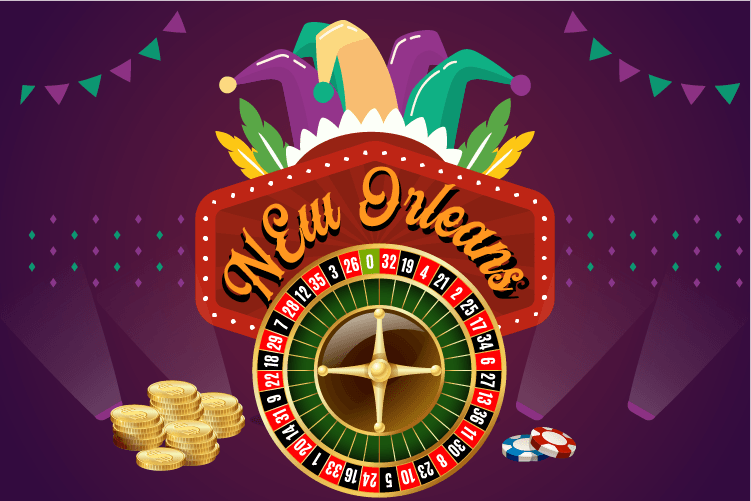
As American typically do, they wanted to make roulette even bigger and better (for the house). A third house slot was added – the American eagle slot – which increased the house edge to an incredible 12.9 percent. This variety of roulette wasn’t popular for long though, and as a result was dropped after a few years.
And nothing much more has changed moving forward, we’ve stuck with the same two games for over a hundred years, with European roulette being popular in France, Britain and the rest of the continent, while American roulette remains popular in the States.
Towards the end of the 19th century roulette became the most popular variant of casino game, attracting the most fashionable clientele in Monaco, France and the USA. In the mid-1800s Germany banned casino gaming, along with roulette and so, the Family Blanc (who had made their fortune from gambling in Germany), moved to Monte Carlo. It soon became renowned for being the number one gambling hotspot in the world, for those who could afford to travel that is.
From the 20th century onwards, Monte Carlo and Las Vegas – moving from its home in New Orleans – became the hub of casino gaming. That was until casinos started to spring up everywhere, from Italy to Manchester, England. The rise of the online casino was next and soon everyone could access the ‘devil’s game’ from their phone, tablet or mobile. In-fact, roulette is one of the most played games across the world simply due to how accessible it is.
Rules of roulette
The rules for roulette depend on whether you’re playing in-house and online, but they generally follow the same format. Generally, the casino will impose minimum and maximum bets, especially for the outside bets. Usually, the minimum bet for inside bets is lower than outside. So, for example, there might be a minimum bet of £1 on inside bets (a lot of tables have this minimum nowadays), while on outside bets it might be £50.
Between spins you will have an allotted time to place bets. Once the dealer has called ‘no more bets’, or ‘rein ne va plus’, you must not place any more chips on the table, or they will be void.
The dealer will then spin the wheel and when the ball stops, they will place a marker, or dolly on the table. Any touching, or surrounding chips will be paid out, while others will be recouped by the house. While the dolly remains on the table players are not allowed to touch chips, place more chips down or collect bets. Once bets have been paid the dolly will be removed, chips are placed down and betting starts again.
Overview of the roulette table
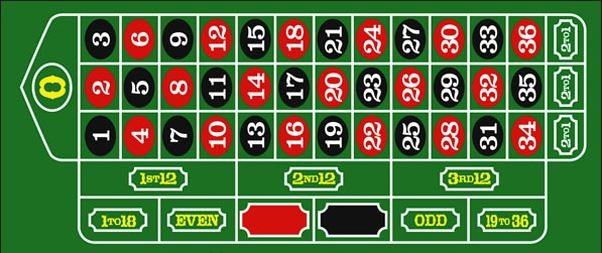
The roulette table hasn’t changed much over the last hundred or so years and looks pretty much identical to the original. Split into three sections, the table is comprised of the inside bets (the numbers 1 – 36, and the 0 (or 00 if playing American Roulette), the outside bets on the right (viewing the table from the wheel upwards), which contains the evens bets (1 to 18, 2 to 26, odd, even, black, red) and the 2:1 bets (1st dozen to 3rd dozen); and finally, the outside bottom bets, containing the 1:3 column bet.
Some tables (actually, the majority) at the casino might have the option of selecting special bets, known as neighbour bets:
- Les Orphelins: This is a bet on the numbers that are adjacent on the wheel, but separated on the table: 6, 34, 17, 1, 20, 14, 31 & 9
- Tiers du Cylindre: A bet on all the numbers adjacent on the layout, but separate on the wheel: 27, 13, 36, 11, 30, 8, 10, 5, 24, 16 & 33
- Voisins du Zero: Here you bet on all the numbers next to zero: 25, 2, 21, 4, 19, 15, 32, 0, 26, 3, 35, 12, 28, 7, 29, 18 & 22
These bets can be called, or they can be placed by putting chips down on allocated sections of the board. It will be apparent which you are required to do from the layout of the table.
Roulette bets in more detail
Once you have an understanding on the roulette table, it is wise to recap on the bets you can place.
Depending on where you are playing, they will be referred to by their French or English title. For ease of use, we’ll detail both:
- Straight up/En plein: Single bet on the table, on one number only. Example: Placing £5 on the number 22.
- Split: A single bet between two numbers. Example: Placing a £5 bet on numbers 2 & 3.
- Corner bet/Carré: A bet on four numbers with one single chip. Example: Placing a £5 chip on the apex between 16, 17, 19 & 20.
- Street bet/Tranversale: Betting on the line of the 12 numbers at the bottom of the table. This activates the two above, along with the bottom number. Example: Placing a bet on the bottom line of 16, which activates 16, 17 and 18.
- Six line/Double street: By placing a bet in-between two numbers on the bottom line (not within the table, but on the edge), you activate the six numbers above. For example: Placing a bet on the bottom line between 1 & 2 would activate 1, 2, 3, 4, 5 and 6.
- Trio: Here you place a chip on 0 and any two numbers adjacent. For example: Placing a bet on 0, 1 & 2.
- Basket/First Four: With this bet you place a chip on 0 and the three numbers closest to zero. For example: 0, 1, 2 & 3, by placing a chip on the outer corner shared by 0-1, or 0-3.
- Top line: For American roulette only, this is a bet on 0-00-1-2 & 3. For example: Placing a bet on the outer corner shared by 0-1, or 00-3.
- Then you have the outside bets, which are a lot easier to understand (generally self-explanatory):
- 1st, 2nd and 3rd twelve: Here you bet on whether the ball will land between 1 – 12, 13 – 24 or 25 – 36.
- 1 to 18/19 to 36: This bet allows you to cover the first half (1 to 18), or second half (19 to 36) of the table.
- Red/Black: One of the most popular bets in roulette. Here you decide whether the ball lands on red, or black.
- Even/Odd: Here you bet on whether or not the ball will land on an even or odd number.
- 2:1 bet: Here you bet on the whole row of the inside bet section. Much like the 1st, 2nd and 3rd dozen bet, but instead you’re betting on a different group of numbers.
Roulette guide point 1 : always have a strategy!
On the internet you will often see strategies, or techniques that will guarantee your time at the casino is profitable; unfortunately, this is impossible.
Every spin of the roulette wheel is independent and as such cannot be predicted. This means that strategies such as the martingale system, which has you double your bet every time you lose, on the surface seem rather tempting. Unfortunately, there is the potential that you could go on a 15 spin losing streak. To maintain this system, one would need an almost unlimited bankroll just to potentially break even.
Here are a list of strategies that one should avoid:
• Whittacker System
• Pluscoup System
• Parlay System
• Oscars Grind System
• Martingale System
• Lucky Number System
• Law of Thirds System
• Labouchere System
• Hollandish System
• Guetting System
• Fibonacci System
• Dozens and Columns System D’Alembert System
While we’re not going into detail about the systems above, we advise you to google them and take a look for yourself. They generally rely on doubling your bet after a certain situation, and are ultimately progressive betting plans.
Below we’ll list a few myths that crop up in the casino from time to time:
Hot and cold numbers in roulette
In some roulette circles, there is this idea that if a number hasn’t come up in roulette, it’s more likely to come up next. Casinos have cottoned on to this belief by actively demonstrating which numbers are ‘hot’ (the five most popular numbers in the last 50 spins), and numbers that are ’cold’ (the five which have appeared the least in the last 50 spins), which further adds to the legitimacy of hot and cold numbers. Unfortunately, this is all nonsense.
As explained before, the ball has no memory and every spin is independent. Which means, once the wheel has been restarted, the odds of the ball landing in the number two for example, are the same as the previous spin. This pretty much makes hot and cold numbers redundant, so forget them and just bet on what you like.
Biased wheels
At one point in time, way back in the 1900s/1910s, roulette wheels were mechanic and subject to human error. Machine-made wheels were a while off and so, these hand-crafted wheels were subject to manufacturer error. What this meant was that, during the course of a thousand spins, the ball would land in three or four numbers more than others. This was due to the wheel being off-balance and so, if spotted, could be taken for a lot of money.
Joseph Jagger, for example, was one example of someone who managed to take advantage of a biased wheel. In 1873 he employed six clerks to note the results of a roulette table over an extended period of time, took the information, and from that found that one wheel in particular showed a tendency towards nine specific numbers. From this he made around £65,000 from the Beau-Arts Casino in Monte Carlo; nowadays, this would be around £3 million.
Unfortunately, today’s wheels are made using high-tech machinery and are often perfect to the 99th percentile. Exploiting biased wheels online is impossible, with computer algorithms controlling the results of every individual game. When it comes down to it, attempting to exploit any ‘biased’ wheel today is foolish, and will often result in you losing a lot more than you win.
Dealer signatures
Another theory shot about the casino is that dealers can influence where the ball lands by practising their spins.
This is nonsense for a number of reasons:
• Roulette wheels have pins around the edge of the wheel, which causes the ball to bobble randomly around the wheel. Even if the dealer could control how many time the ball goes around the wheel, the pin would eventually cause it to bounce in an uncontrolled direction
• Pockets in the modern roulette wheel are so shallow that the ball has to land perfectly within. Even if the dealer was able to land the ball in a pocket, there is a good chance it would bounce out in a random direction.
• Dealers also have no reason to do this. They gain nothing from helping the player, and if caught, could stand to lose their job.
• Finally, dealers move tables often, so even if they were familiar with one table, they would struggle with another
If someone claims they know a magic dealer, then honestly, just run away.
Roulette Guide point 2 : Roulette odds
House edge in roulette
Before we explore the odds of roulette, we need to talk about house edge. Basically, every game in the casino pays a certain amount back to the house after x amount of spins. It is often expressed as a percentage out of hundred, with the house edge being what the casino recoups after £100. If the house edge is 10%, then on average, the player would receive £90 and the house would receive £10. This figure isn’t set though, and can increase and decrease due to time played, but generally, after extended play, it remains true.
So, the house edge of the two most popular roulette games varies, with one being higher than the other. House edge in roulette European roulette is 2.7 percent, while the house edge in American roulette is 5.26 percent. As you can guess, the difference is substantial for the player. If you remember from the first section, we said the Americans added the extra green zero to influence the house edge. This 2.56 percent raise in house edge increases the casino’s profits substantially.
This is why we will always advise you to play European roulette!
From this we can then take a look at the generic odds in roulette:
- Bet American Roulette (0, 00) European Roulette (0)
- Straight Up 37 to 1 36 to 1
- Row 18 to 1 N/A
- Split 18 to 1 17 ½ to 1
- Corner 8 1/2 to 1 8 ¼ to 1
- Street 11 1/3 to 1 11 1/3 to 1
- 1st, 2nd and 3rd dozen 2 1/6 to 1 1 1/18 to 1
- Odd/Even 1 1/9 to 1 1 1/18 to 1
- Red/Black 1 1/9 to 1 1 1/18 to 1
- 1 to 18/19 to 36 1 1/9 to 1 1 1/18 to 1
As you can tell from the above, the true value lies in playing European roulette. Not only is the house edge better, but you’re also getting better odds. So, whether you’re in America or not, find that European roulette table!
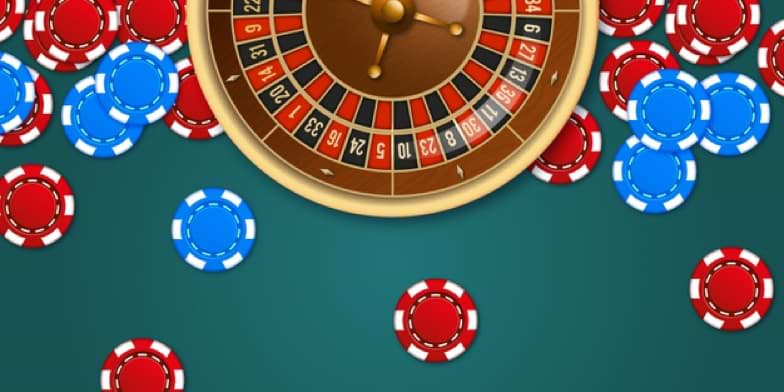
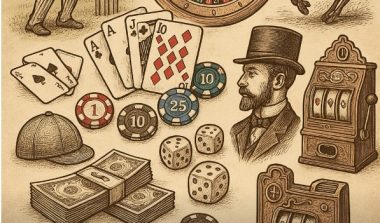
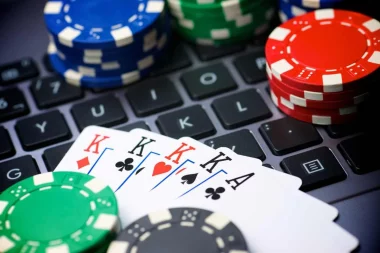




Leave a Reply